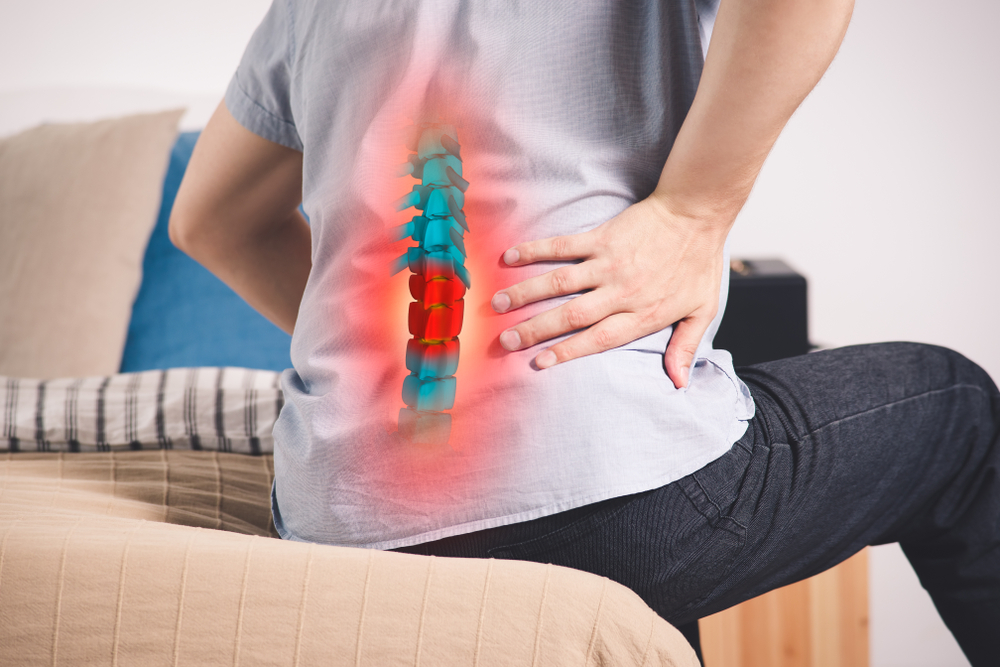
16 Sep What is a slipped disc?
The vertebrae that make up your spinal column are stacked one on top of the other. The column is made up of seven cervical spine bones, twelve thoracic spine bones, five lumbar spine bones, the sacrum, and finally the coccyx at the base. Discs support these bones and cushion them. They absorb the shocks from regular actions like walking, lifting, and twisting. The discs actually shield the bones from injury.
Each disc is composed of an outer ring and a soft, gelatinous interior component. The interior part of the disc may poke through the outer ring due to damage or weakness. A slipping, herniated, or prolapsed disc is what this is. This is not only uncomfortable but also painful. You might also feel numbness and discomfort along the afflicted nerve if the slipped disc compresses a spinal nerve. If the situation is serious, you might need surgery to remove or fix the slipped disc.
Now, you may be wondering what are the signs that indicate a slipped disc? Any area of your spine, from your neck to your lower back, is susceptible to slipped discs. One of the more typical places for slipping discs is the lower back. Your spinal column is a complex web of blood vessels and nerves. The muscles and nerves nearby can experience increased pressure as a result of a slipped disc. The following are signs of a slipped disc:
- Usually on one side of the body, pain and numbness that spreads to your arms or legs
- An ache that gets worse at night or when performing particular motions
- Discomfort that gets worse after standing or sitting discomfort after taking brief walks
- A mysterious muscular weakness
- A feeling of tingling, aching, or burning in the affected area
You are more likely to get a slipped disc as you age. This is due to the fact that as you get older, your discs start to lose part of their protective water content. They are therefore more likely to move out of place. Men experience them more frequently than women.
How is a slipped disc diagnosed or identified?
Your doctor will examine you physically first. They’ll be searching for the cause of your discomfort and agony. To do this, it will be necessary to assess your nerve and muscle strength as well as whether you experience pain when moving or contacting the affected area. In addition, your doctor will inquire about your health history and symptoms. Your doctor will be keen to find out when you first experienced any symptoms and what activities aggravate your pain.
Your doctor can see your spine’s bones and muscles with the aid of imaging scans to look for any damaged areas. Imaging scan examples are inclusive of X-rays, A CT scans, MRI images, and discograms. All of these pieces of information can be put together by your doctor to pinpoint the source of your pain, weakness, and discomfort.
What issues can arise from a slipped disc?
Permanent nerve damage might result from a significant slipped disc that is left untreated. A slipped disc may, in extremely rare circumstances, prevent nerve impulses from reaching the cauda equina nerves in your lower back and legs. You could lose control of your bowels or bladder if this happens. The condition known as saddle anaesthesia is another long-term consequence. Your inner thighs, the back of your legs, and the area around your rectum go numb as a result of the slipped disc compressing your nerves. While a slipped disc’s symptoms may get better, they might also get worse. It’s time to contact your doctor and get a check up if you are unable to engage in the activities you formerly enjoyed.
What is the treatment for slipped discs?
A slipped disc can be treated surgically or conservatively. The course of treatment is usually determined by how much pain you’re in and how much the disc has moved out of place.
Using an exercise regimen that stretches and strengthens the back and surrounding muscles, the majority of people can get relief from slipped disc discomfort. Exercises that might strengthen your back and lessen your back discomfort may be suggested by a physical therapist.
Additionally helpful are using over-the-counter painkillers, avoiding strenuous activity, and uncomfortable positions.
When you have a slipped disc, it may be tempting to avoid all physical activity, but doing so can cause muscle weakening and joint stiffness. Instead, make an effort to stay as active as you can by stretching or engaging in low-impact sports like walking.
Stronger medications may be prescribed by your doctor if the pain from a slipped disc does not go away with over-the-counter remedies. These consist of the following: drugs that relax the muscles to treat spasms, narcotic painkillers, such as gabapentin or duloxetine, as well as nerve pain relievers.
If the pain or symptoms persists then your Dr may recommend an Epidural steroid injection or selective nerve root injection to help decrease the discomfort and pain . Lot of patients respond well to this treatment and can avoid a potential surgery .
If your symptoms do not go away after six weeks or if your slipped disc is impacting your ability to use your muscles, your doctor might advise surgery. Without removing the complete disc, your surgeon may only cut away the damaged or bulging area. This is what is called a microdiskectomy.In more serious situations, your doctor can remove the disc and fuse your vertebrae together or replace it with an artificial one. Your spinal column is strengthened by this treatment, a laminectomy, and a spinal fusion.
How likely is it that someone with a slipped disc would recover?
The majority of patients with a slipped disc react favourably to conservative therapy. Their discomfort and suffering will progressively fade after six weeks.
Can a disc be prevented from slipping?
Even though it may not be a 100% possible to prevent a slipped disc, you can take some precautionary measures to lessen your chances of developing one. Some basic activities and excerices can be adhered to avoid this type of situation. These activities include simple things like: bending at the knees rather than the waist while lifting heavy objects, maintaining a healthy weight, staying seated for long periods of time – try to occasionally stand up, stretch, and move around. To strengthen your back, legs, and stomach muscles, exercise them.
If you are experiencing any pain or symptoms similar to what we have described, get in touch with us to set up an appointment.


